The Trzepak*
A social sculpture and workshop-based project about community, place, and imagination. Based in Łódż, Poland.
2023
*A trzepak (CHEH-pock, carpet-beater) is a monument to a communist past that still exists in the urban landscape of former Eastern Bloc countries. Neighbors hung their household carpet over their closest trzepak to beat the dirt and dust out of it. Trzepaki were placed in central, semi-public spaces, and were often used as makeshift play structures. The trzepak was a place where the private and public met.
 Above and left: historical trzepak photos
Above and left: historical trzepak photosThis project started as a workshop series with textiles students at the Academy of Fine Arts in Łódż. Inspired by the trzepak’s role in play and as a meeting place, we created a set of floor cushions that could be placed around the trzepak to facilitate conversations and hangouts.
My obsession with the trzepak as a sculptural form and social institution spread to the neighborhood, and the neighbors and I collaborated to install a physical trzepak in the courtyard as a symbol and monument (and climbing structure).
As a final element of this project students and neighbors also collaborated on a community textile.
 The Trzepak (with neighborhood kids). Installed in Łódż, Poland in the courtyard of Piotrkowska 36/38 in Łódż, Poland. 2023
The Trzepak (with neighborhood kids). Installed in Łódż, Poland in the courtyard of Piotrkowska 36/38 in Łódż, Poland. 2023Part 1:
The Workshops
Over the course of the academic year, I led six textile workshops during which participants from the neighborhood, the non-profit, and the art academy drew on their associations and memories of the trzepak to create tops for the cushions. These were then sewn together by volunteers from the community.
The cushions were used by the community as extra seating at dinner parties and community events. The cushions reflected their makers as well as Polish folk art and craft traditions.
This project started as a workshop series with textiles students at the Academy of Fine Arts in Łódż, and eventually grew to include the tenants of Piotrkowska 36/38 in the city’s downtown, and Stowarzyszenie dla Rodziny, a non-profit organization supporting families with eldercare, mental health resources, and assistance for clients with physical and intellectual disabilities.
Inspired by its role in play and as a meeting place, the students chose to create floor cushions that could be placed around the trzepak to facilitate conversation.
The Workshops
Over the course of the academic year, I led six textile workshops during which participants from the neighborhood, the non-profit, and the art academy drew on their associations and memories of the trzepak to create tops for the cushions. These were then sewn together by volunteers from the community.
The cushions were used by the community as extra seating at dinner parties and community events. The cushions reflected their makers as well as Polish folk art and craft traditions.
This project started as a workshop series with textiles students at the Academy of Fine Arts in Łódż, and eventually grew to include the tenants of Piotrkowska 36/38 in the city’s downtown, and Stowarzyszenie dla Rodziny, a non-profit organization supporting families with eldercare, mental health resources, and assistance for clients with physical and intellectual disabilities.
Inspired by its role in play and as a meeting place, the students chose to create floor cushions that could be placed around the trzepak to facilitate conversation.
Part 2
Social Sculpture
Over the course of working together, Stowarzyszenie dla Rodziny and participating neighbors received a development grant for improvements to the courtyard, including the install of a physical trzepak.
The Trzepak was completed in advance of an annual celebration on September 30, 2023 during which we officially cut the ribbon on the project and presented it to the community and the local press. The textile was then moved to its permanent location (in front of a disused exterior window).
Social Sculpture
Over the course of working together, Stowarzyszenie dla Rodziny and participating neighbors received a development grant for improvements to the courtyard, including the install of a physical trzepak.
The Trzepak was completed in advance of an annual celebration on September 30, 2023 during which we officially cut the ribbon on the project and presented it to the community and the local press. The textile was then moved to its permanent location (in front of a disused exterior window).
 Residents and Stowarzyszenie dla Rodziny staff choosing a spot to place the Trzepak in their courtyard.
Residents and Stowarzyszenie dla Rodziny staff choosing a spot to place the Trzepak in their courtyard.  Donated trzepak delivery
Donated trzepak delivery
The Trzepak and the final communnity textile installed in the courtyard. The site was sometimes visited by school groups and city tours due to its proximity to the city’s main drag and other visual art attractions.


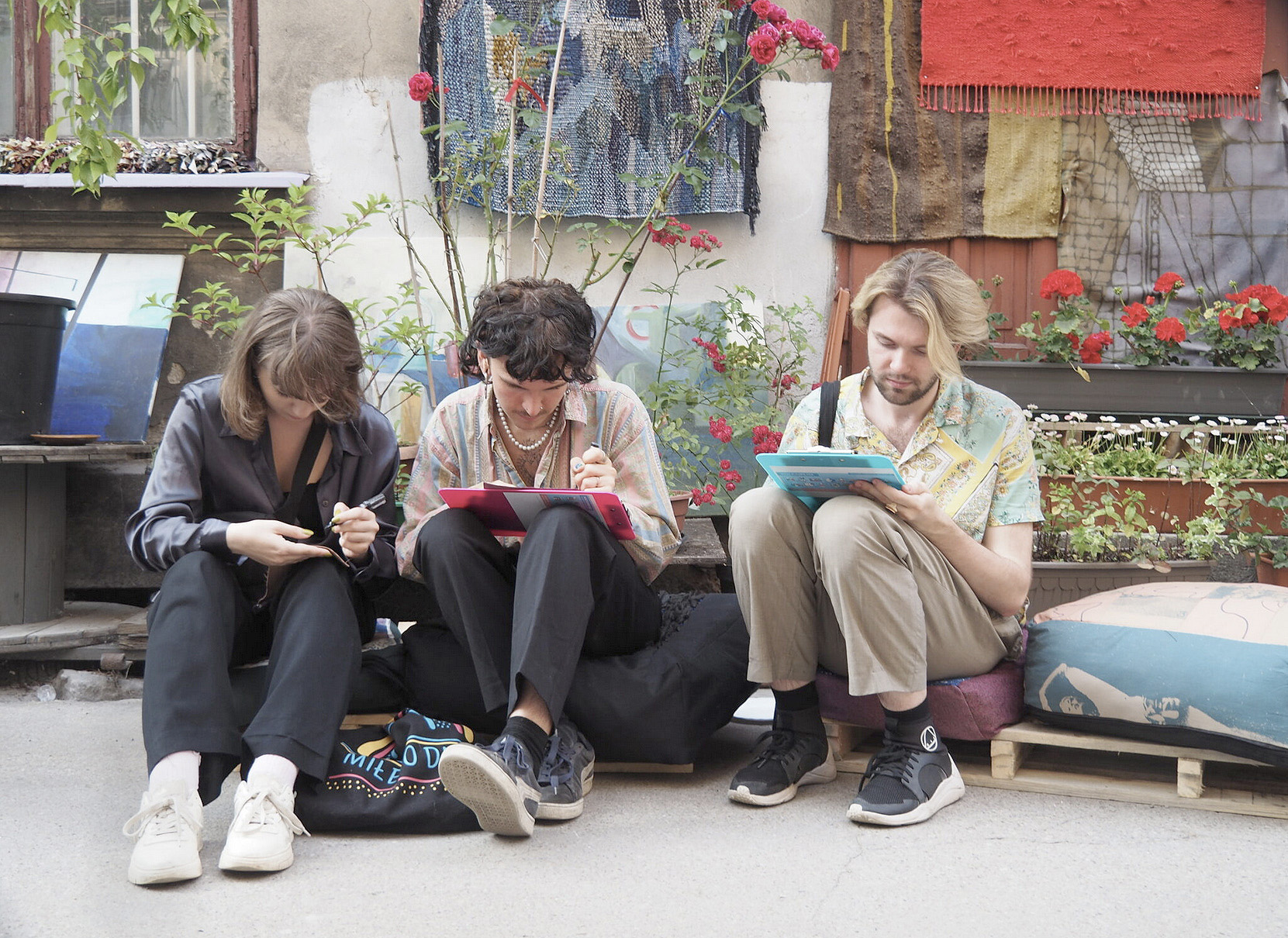
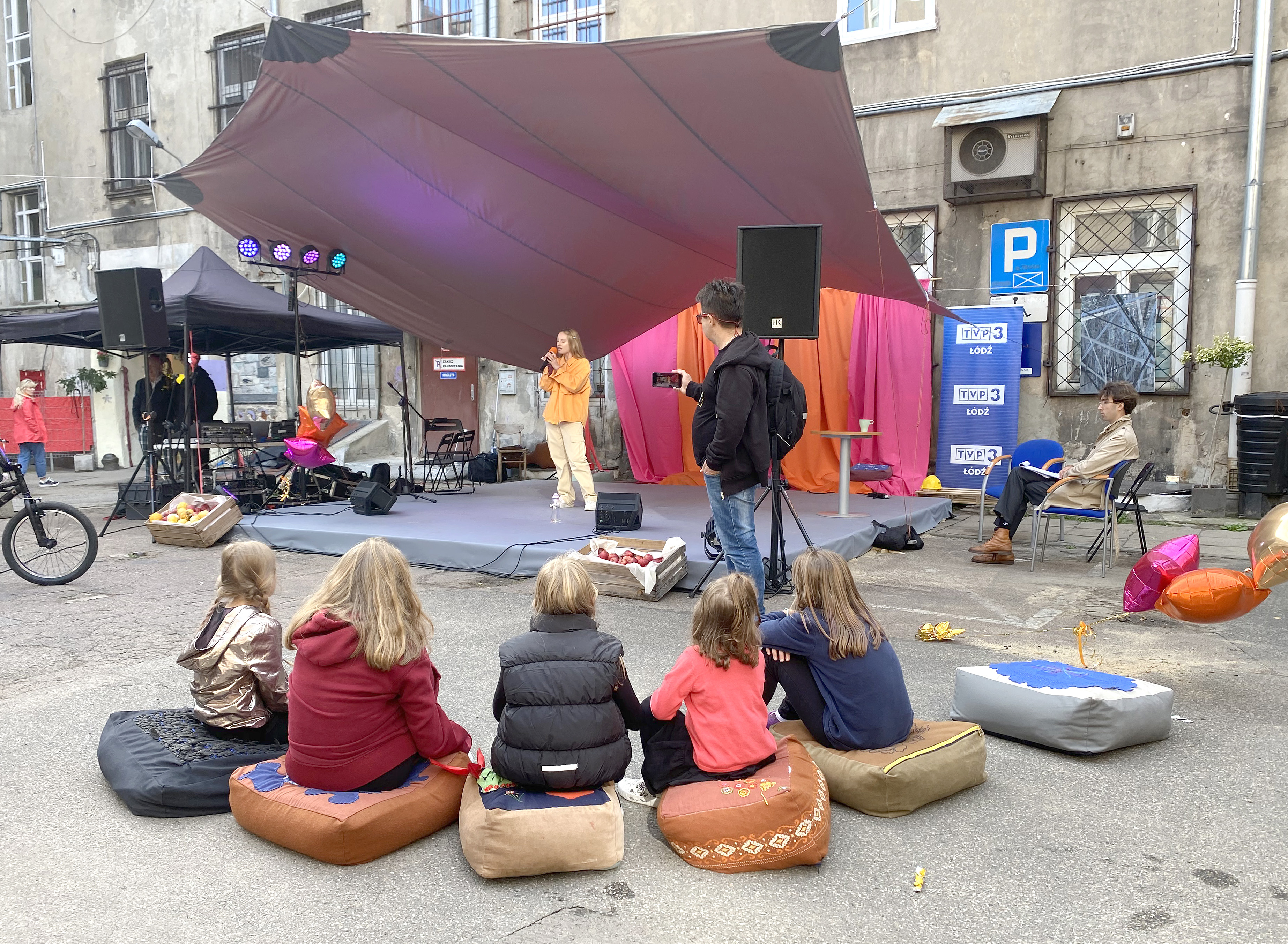


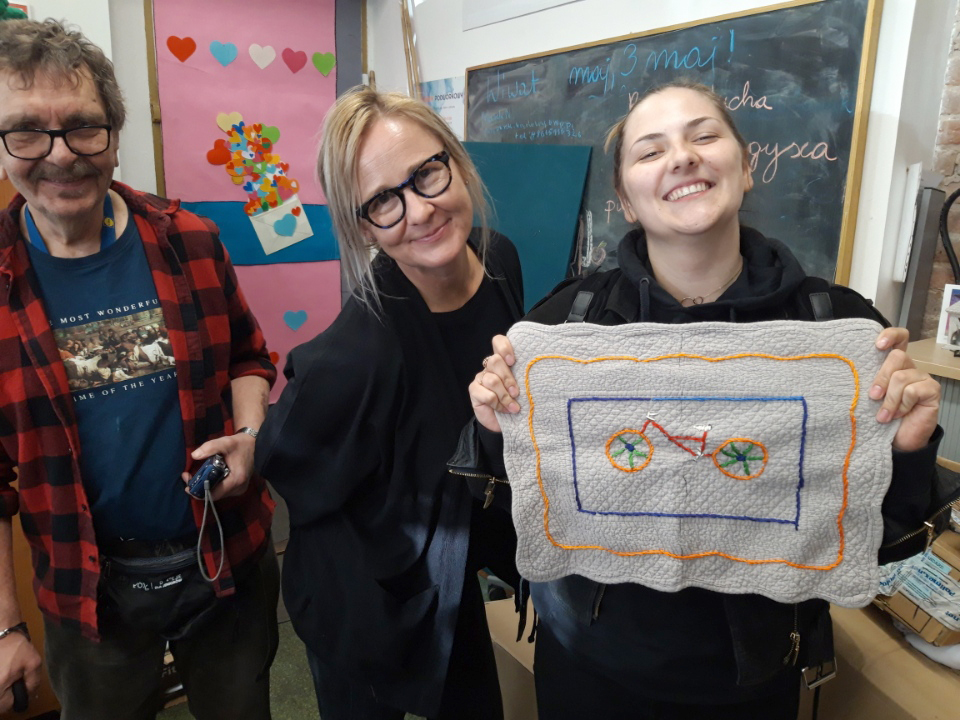





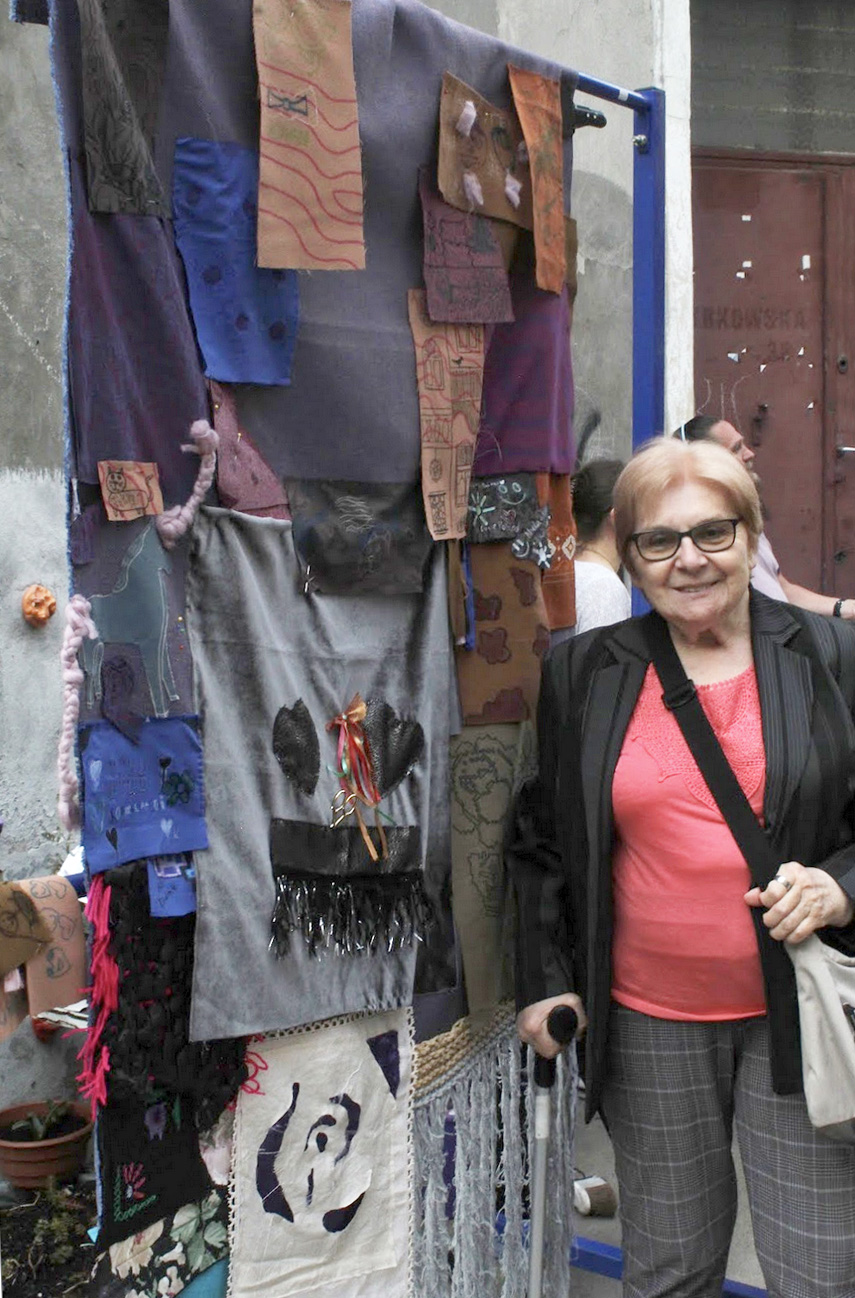







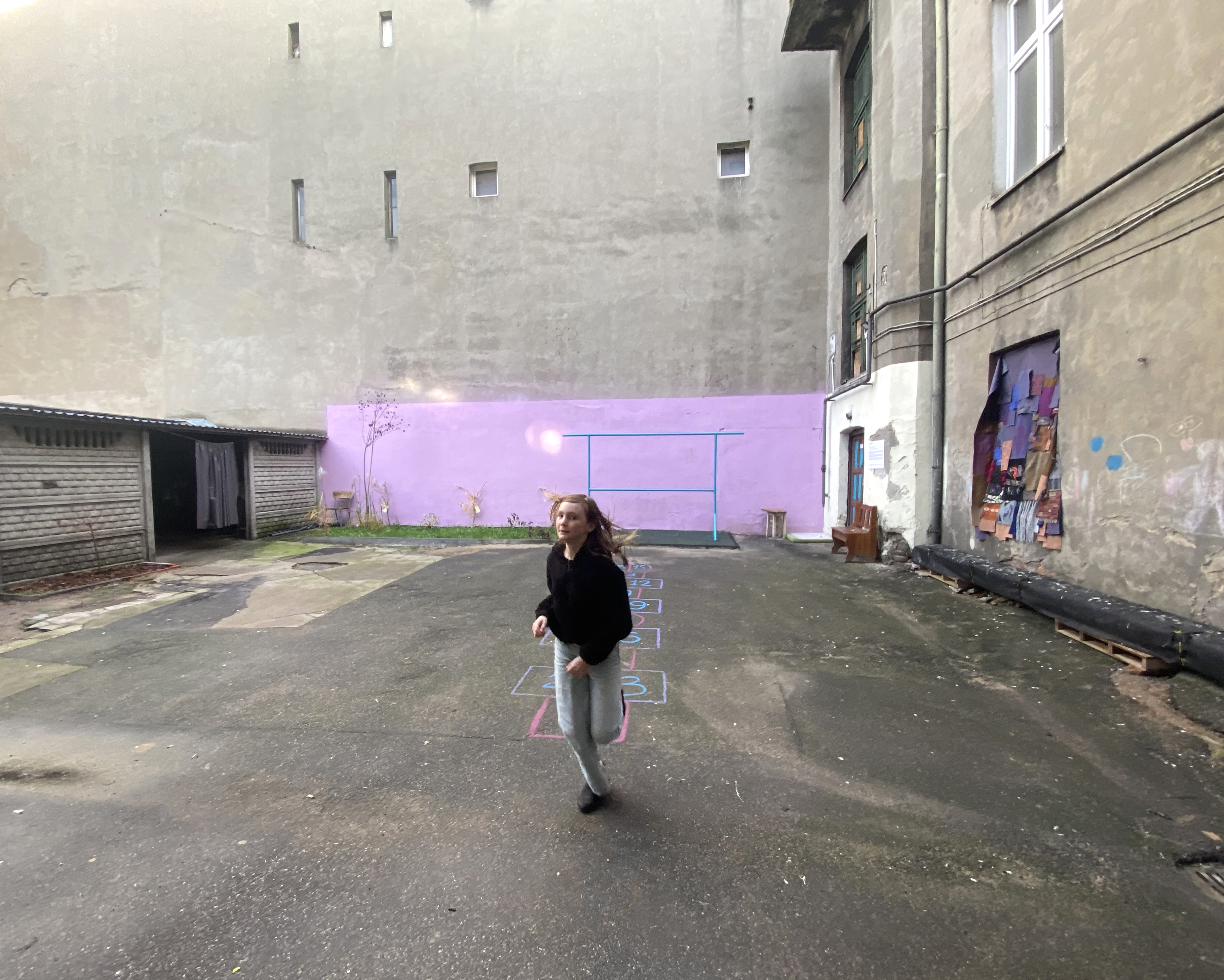
1-3
Neighborhood cookout event and final picnic for the project, in June and October 2023. Students adding to the community textile, with cushions in use
4-6
Workshops with clients and staff from Stowarzyszenie dla Rodziny
Neighborhood cookout event and final picnic for the project, in June and October 2023. Students adding to the community textile, with cushions in use
4-6
Workshops with clients and staff from Stowarzyszenie dla Rodziny
7-10
Completed cushions, including one featuring a screen-print of a well-known regional embroidery motif.
11, 12
Working on the community textile
13, 19
More views of The Trzepak sculpture
Completed cushions, including one featuring a screen-print of a well-known regional embroidery motif.
11, 12
Working on the community textile
13, 19
More views of The Trzepak sculpture
14-16
The final community textile as opresented and installation view
17. Historical photo from the courtyard of Piotrkowska 38, pre-WWII
17b. Same view in 2023
The final community textile as opresented and installation view
17. Historical photo from the courtyard of Piotrkowska 38, pre-WWII
17b. Same view in 2023
Project Background
Excerpts from the slide deck presentation of the project to students












In cooperation with:
– Prof. Zygmunt Łukasiewicz
– Stowarzyszenie Dla Rodziny ( staff, volunteers, and clients),
– Residents of Piotrkowska 36/38,
– and the textile design workshop of Dr. Izabela Walczak, Academy of Fine Arts. Łódż, Poland.
Special thanks:
– Piotr and Izabela Chuchler of Stowarzyszenie Dla Rodziny.
– Cushion sewing and construction: Beata Kośka and Oksana Mikheienkp.
– Trzepak transport: Tomasz Zawadowski
– Project documentation: Klaudia Borzęcka and Mike Seely
– Prof. Zygmunt Łukasiewicz
– Stowarzyszenie Dla Rodziny ( staff, volunteers, and clients),
– Residents of Piotrkowska 36/38,
– and the textile design workshop of Dr. Izabela Walczak, Academy of Fine Arts. Łódż, Poland.
Special thanks:
– Piotr and Izabela Chuchler of Stowarzyszenie Dla Rodziny.
– Cushion sewing and construction: Beata Kośka and Oksana Mikheienkp.
– Trzepak transport: Tomasz Zawadowski
– Project documentation: Klaudia Borzęcka and Mike Seely
Student participants:
Marta Bartel
Klaudia Boręcka
Karolina Chyc
Wojciech Gomularz
Karolina Kara
Karolina Kędzia
Aleksandra Kropidlowska
with Paulina Soltyszewska
Made possible as part of a 2022/23 Fulbright research grant to Poland
Marta Bartel
Klaudia Boręcka
Karolina Chyc
Wojciech Gomularz
Karolina Kara
Karolina Kędzia
Aleksandra Kropidlowska
with Paulina Soltyszewska
Made possible as part of a 2022/23 Fulbright research grant to Poland